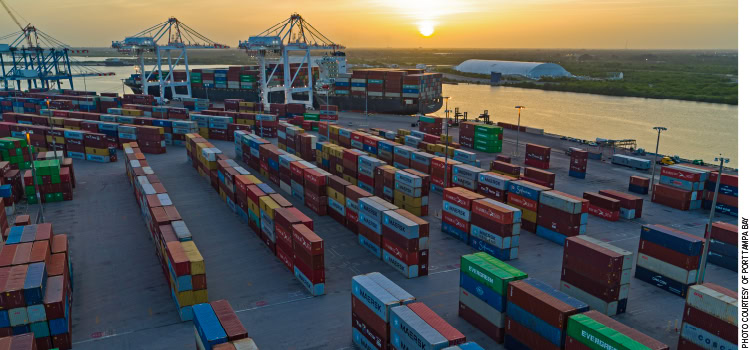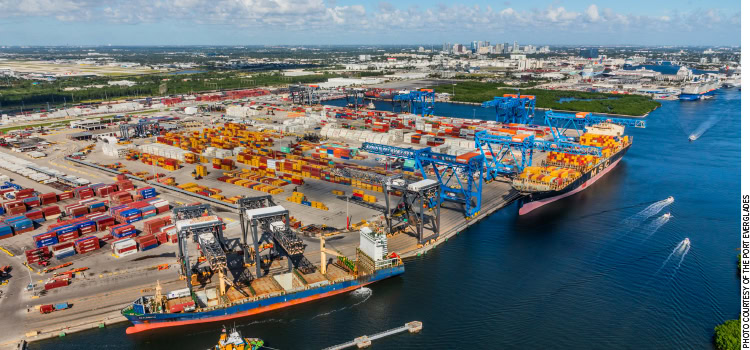U.S. Ports Surging

These major U.S. gateways complete infrastructure updates and increase operational efficiency to support increasing cargo demands.
The U.S. port industry plays a critical role in driving the nation’s economy—generating jobs, facilitating trade, and supporting communities across the United States. U.S. ports contribute nearly $3 trillion to the national GDP and support 1 in every 8 American jobs, according to the 2024 Economic Contribution Report by the American Association of Port Authorities.
The tremendous growth in port operations and the vital role they play in ensuring the stability and success of the U.S. economy is evident in our everyday lives and well documented in the AAPA report. Here is a look at two leading Florida gateways.
No Longer Florida’s Best-Kept Logistics Secret, Port Tampa Bay Takes Center Stage

Port Tampa Bay
Port Tampa Bay has solidified its position as Florida’s new supply chain solution with the addition of many new container shipping services, a game changer for the state’s logistics landscape.
With multiple container shipping options and Tampa’s central proximity in the state, the port provides significant supply chain efficiencies and cost savings to importers and exporters serving the rapidly growing Florida market from the state’s distribution hub—which encompasses the I-4 Corridor as well as the burgeoning DC development along I-75 around Tampa.
The recent expansion of container services from Asia, Central America, and South America, including the new Cartagena-Tampa America Shuttle 2 operated by Maersk and Hapag-Lloyd, has been critical in serving Florida’s largest and fastest-growing market.
Home to the state’s largest concentration of distribution centers, the Central Florida region has more than 550 million square feet of DC space right in Port Tampa Bay’s backyard. The port continues to see double-digit growth in containerized cargo, with more opportunities on the way with trade expansion in Latin America.
Get Closer to Customers
This region is also one of the hottest industrial real estate markets in the country and Florida’s hub for distribution, logistics, and manufacturing. Florida now has the 15th largest economy in the world and is the fastest-growing state in the country.
Home to nearly half of the state’s 23 million residents and welcoming a majority of the 143 million visitors each year, the Central Florida region is also the fastest-growing part of the state. In fact, three Tampa Bay counties—Polk, Hillsborough, and Pasco—are among the fastest growing in the country.
Port Tampa Bay is no longer Florida’s best-kept logistics secret—it’s the state’s most strategic, cost-effective container gateway. Serving the Tampa/Orlando I-4 and I-75 Corridor—Florida’s industrial engine and home to more than 400 distribution centers—Port Tampa Bay offers unmatched inland cost savings, multi-directional access, and scalable infrastructure.
Beneficial cargo owners are seeing significant savings in their drayage and distribution costs as truckers make as many as 3 to 4 round-trip deliveries per day from Port Tampa Bay to their DCs. Customers also benefit from attractive northbound backhaul truck rates to extend their reach into markets throughout the Southeast and beyond.
Growth to Meet Demand
Port Tampa Bay, along with container terminal operator Ports America, has accommodated the growth in Florida by staying ahead of the curve thanks to its terminal build-out program. Recent expansion includes a new container gate complex, additional container storage area to reach 100 acres, and two new post-Panamax cranes on order to accompany the existing four STS post-Panamax cranes.
Additionally, construction has commenced to extend the berth from 3,200 to 4,500 linear feet. The state of Florida strongly supports its ports, and Tampa Bay offers the best long-term growth potential due to its available land and strategic location.
www.porttb.com
www.porttb.com/contact
800-741-2297
How Port Everglades Paves the Way To Operational Efficiency

Port Everglades
Cargo terminal operators at Port Everglades do the heavy lifting. The landlord port paves the way.
The port’s strategic location, infrastructure investments, and operational efficiency provide the competitive edge that cargo customers seek.
Port Everglades, located in South Florida, has direct highway access, an international airport within two miles, and a 43-acre international and domestic intermodal container transfer facility that makes it possible for cargo shipped through the port to reach Atlanta and Charlotte within two days and 70% of the U.S. population within four days.
The port is also home to South Florida’s Foreign Trade Zone No. 25, which is both a grantee and an operator. The dual role provides qualified import and export companies based in Broward County the flexibility to choose the level of support they want in managing their Foreign Trade Zone operations.
Port Everglades handles an average of one million TEUs annually and connects with 150 ports in 70 countries, making efficiency a top priority. Its busiest trade lane is with Latin America and the Caribbean.
In all key measures, the port’s operational performance climbed significantly based on the World Bank’s latest Container Port Performance Index analysis of 2023 data.
Port Everglades is in the top 20% of ports across the world at No. 65; No. 3 in North America; and remains No. 1 in Florida.
The rankings primarily can be attributed to the port’s infrastructure improvements, such as the five new berths and 1,500 feet of quay added to its expanded turning notch, the installation of six Super Post-Panamax container gantry cranes, real-time video feeds to manage truck flow in the Southport cargo area, and technology and equipment investments by cargo terminal operators.
The port’s 20-Year Master/Vision plan includes additional ways to boost productivity and ensure the port is resilient for future growth.
Below the surface, the port is undergoing an estimated $268-million project to replace bulkheads that have reached the end of their service life. The new bulkheads will enhance the structural integrity and safety of the berths for all marine vessels and can be adapted for sea level rise.
Another major project, with construction scheduled to begin in 2028, is the Slip 1 public-private partnership. The collaboration will expand the main petroleum berth by 150 feet to accommodate new Aframax ships.
In the coming months, under its Master/Vision plan update, Port Everglades will continue to develop innovative and competitive solutions to help cargo customers move goods to the market faster.
PortEverglades.net
[email protected]
800-421-0188
